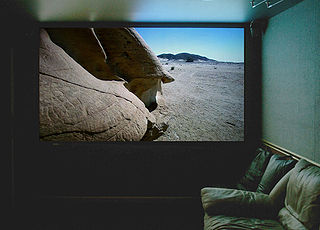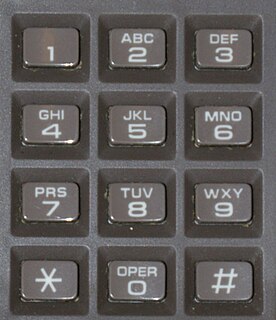
An overhead projector (OHP) is a variant of slide projector that is used to display images to an audience..
Electronic voting is voting that uses electronic means to either aid or take care of casting and counting votes.

An LCD projector is a type of video projector for displaying video, images or computer data on a screen or other flat surface. It is a modern equivalent of the slide projector or overhead projector. To display images, LCD projectors typically send light from a metal-halide lamp through a prism or series of dichroic filters that separates light to three polysilicon panels – one each for the red, green and blue components of the video signal. As polarized light passes through the panels, individual pixels can be opened to allow light to pass or closed to block the light. The combination of open and closed pixels can produce a wide range of colors and shades in the projected image.

A video projector is an image projector that receives a video signal and projects the corresponding image on a projection screen using a lens system. All video projectors use a very bright light or laser to project the image, and most modern ones can correct any curves, blurriness, and other inconsistencies through manual settings.

Digital Light Processing (DLP) is a set of chipsets based on optical micro-electro-mechanical technology that uses a digital micromirror device. It was originally developed in 1987 by Larry Hornbeck of Texas Instruments. While the DLP imaging device was invented by Texas Instruments, the first DLP-based projector was introduced by Digital Projection Ltd in 1997. Digital Projection and Texas Instruments were both awarded Emmy Awards in 1998 for the DLP projector technology. DLP is used in a variety of display applications from traditional static displays to interactive displays and also non-traditional embedded applications including medical, security, and industrial uses.

A television set or television receiver, more commonly called a television, TV, TV set, or telly, is a device that combines a tuner, display, and loudspeakers for the purpose of viewing television. Introduced in the late 1920s in mechanical form, television sets became a popular consumer product after World War II in electronic form, using cathode ray tubes. The addition of color to broadcast television after 1953 further increased the popularity of television sets in the 1960s, and an outdoor antenna became a common feature of suburban homes. The ubiquitous television set became the display device for the first recorded media in the 1970s, such as Betamax, VHS and later DVD. It was also the display device for the first generation of home computers and video game consoles in the 1980s. In the 2010s flat panel television incorporating liquid-crystal displays, especially LED-backlit LCDs, largely replaced cathode ray tubes and other displays. Modern flat panel TVs are typically capable of high-definition display and can also play content from a USB device.

A touchscreen, or touch screen, is an input device and normally layered on the top of an electronic visual display of an information processing system. A user can give input or control the information processing system through simple or multi-touch gestures by touching the screen with a special stylus or one or more fingers. Some touchscreens use ordinary or specially coated gloves to work while others may only work using a special stylus or pen. The user can use the touchscreen to react to what is displayed and, if the software allows, to control how it is displayed; for example, zooming to increase the text size.
A polling place is where voters cast their ballots in elections.

A virtual retinal display (VRD), also known as a retinal scan display (RSD) or retinal projector (RP), is a display technology that draws a raster display directly onto the retina of the eye. The user sees what appears to be a conventional display floating in space in front of them.
Audience response is a type of interaction associated with the use of audience response systems, to create interactivity between a presenter and its audience.
The Nokia 8850 is a mobile phone handset manufactured by Nokia. It was a light alloy-bodied enhanced version of Nokia 8210 model with slider protection of the keypad and white lighting of the keypad and screen. The 8850 is considered to be an un-repairable phone, thus resulting in very few active handsets in the market. Today it remains a collector's item. It also came in gold. It was introduced as a successor of an earlier model, the chrome phone Nokia 8810.
Mobile local search is a technology that lets people search for local things using mobile equipment such as mobile phones, PDAs, and other mobile devices. Mobile local search satisfies the need to offer a mobile subscriber spontaneous access to near-position services and information such as businesses, products, events, restaurant, movie theatre or other local information. Mobile local search is the search and discovery of persons, places, and things within an identifiable space defined by distinct parameters. These parameters are evolving. Today they include social networks, individuals, cities, neighborhoods, landmarks, and actions that are relevant to the searcher's past, current, and future location. These parameters provide structure to vertically deep and horizontally broad data categories that can stand-alone or are combined to comprise searchable directories.
An optical scan voting system is an electronic voting system and uses an optical scanner to read marked paper ballots and tally the results.

Large-screen television technology developed rapidly in the late 1990s and 2000s. Various thin screen technologies are being developed, but only the liquid crystal display (LCD), plasma display (PDP) and Digital Light Processing (DLP) have been released on the public market. A video display that uses large-screen television technology is called a jumbotron. These technologies have almost completely displaced cathode ray tubes (CRT) in television sales, due to the necessary bulkiness of cathode ray tubes. However, recently released technologies like organic light-emitting diode (OLED) and not-yet released technologies like surface-conduction electron-emitter display (SED) or field emission display (FED) are making their way to replace the first flat screen technologies in picture quality. The diagonal screen size of a CRT television is limited to about 40 inches because of the size requirements of the cathode ray tube, which fires three beams of electrons onto the screen, creating a viewable image. A larger screen size requires a longer tube, making a CRT television with a large screen unrealistic because of size. The aforementioned technologies can produce large-screen televisions that are much thinner.
A variety of computer graphic techniques have been used to display video game content throughout the history of video games. The predominance of individual techniques have evolved over time, primarily due to hardware advances and restrictions such as the processing power of central or graphics processing units.
A holographic screen is a two dimensional display technology that uses coated glass media for the projection surface of a video projector. "Holographic" refers not to a stereoscopic effect, but to the coating that bundles light using formed microlenses. The lens design and attributes match the holographic area. The lenses may appear similar to the fresnel lenses used in overhead projectors. The resulting effect is that of a free-space display, because the image carrier appears very transparent. Additionally, the beam manipulation by the lenses can be used to make the image appear to be floating in front of or behind the glass, rather than directly on it. However, this display is only two-dimensional and not true three-dimensional. It is unclear if such a technology will be able to provide acceptable three-dimensional images in the future.

Projection mapping, similar to video mapping and spatial augmented reality, is a projection technology used to turn objects, often irregularly shaped, into a display surface for video projection. These objects may be complex industrial landscapes, such as buildings, small indoor objects or theatrical stages. By using specialized software, a two- or three-dimensional object is spatially mapped on the virtual program which mimics the real environment it is to be projected on. The software can interact with a projector to fit any desired image onto the surface of that object. This technique is used by artists and advertisers alike who can add extra dimensions, optical illusions, and notions of movement onto previously static objects. The video is commonly combined with, or triggered by, audio to create an audio-visual narrative.
In the run-up to the general election on 8 June 2017, various organisations carried out opinion polling to gauge voting intentions. Results of such polls are displayed in this article. Most of the polling companies listed are members of the British Polling Council (BPC) and abide by its disclosure rules.
In the run up to the Greek legislative election of January 2015, various organisations carry out opinion polling to gauge voting intention in Greece. Results of such polls are displayed in this article.














